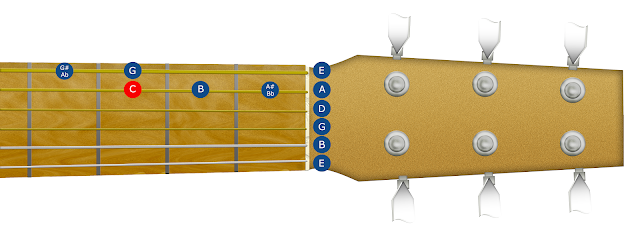In lesson 4, we looked at the important role that third interval notes play in:
- building chords and making them either major or minor
- creating harmony if you want to play them alongside your melody notes.
In this lesson you'll learn how to find third interval notes quickly anywhere on the fretboard.
We've already looked at how the guitar is an instrument tuned around intervals of perfect fourths and major thirds.
You've also learned that the perfect fourth interval note is usually directly below your root note. So, if I play the note G on the E string, I know that the fretted note below it is going to be the perfect fourth interval (the C note):
Let’s just check if that's the case and refresh our memories. Well, the fretted note on the fifth string is the note C. So there should be an interval of a perfect fourth between G and C:
Tonic is G
Flat 2nd is G#
Second is A
Flat third is A#
Major third is B
Perfect fourth is C
If I know that the strings are tuned in intervals of a perfect fourth, I can easily work out where the major third is - it’s just one fret below the perfect fourth.
Locating the third harmony note in relation to the tonic
So you can find the third of any tonic (root) note, by following this pattern, wherever you are on the fretboard:
And remember, when we get to the B string, because it’s tuned at an interval of a third, we would have to move the note on that string half a step to get the same spacing. So on our B string, the third interval note is directly below the tonic note.
Using the octave to find an alternative third interval note
Now, when we played the intro to Blackbird, we found our thirds on the B string, so you may be wondering how that fits in with what I’ve just showed you.
Let me tell you what I mean.
When we played our A melody note, our harmony note was the note C.
Well, I don’t really have another C note available to me in this position.
The closest C I have is 5th fret, third string, and that’s too much of a stretch.
But if I go to the octave note, the next A in this position, I can use this to locate a C on the B string.
If you need to find the minor third, you simply move the third note one fret down the neck, towards the nut.
So, you should now know how to find third interval notes quickly anywhere on the fretboard.
Go to Lesson 6: Finding fifth intervals
Guitar practice journal
Download the Guitar Practice Tracker today. It will help to keep you motivated and give you a visual representation of your progress, and areas of focus throughout the year.
A guitar journal will enable you to:- Set personalised goals and monitor your progress
- Identify the number of hours or days you've spent on a particular skill
- Provide a quick reference to the notes and chords in a particuar key
- List the songs you know and sort by key, capo placement, artist, and chord progression
- Link directly to your favourite YouTube videos and tutorials
Download the Guitar Practice Tracker
If you enjoyed this free lesson, and you're able to, please
Photo by Pavel Danilyuk






